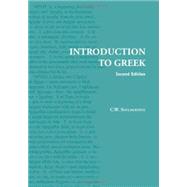
Note: Supplemental materials are not guaranteed with Rental or Used book purchases.
Purchase Benefits
What is included with this book?
The New copy of this book will include any supplemental materials advertised. Please check the title of the book to determine if it should include any access cards, study guides, lab manuals, CDs, etc.
The Used, Rental and eBook copies of this book are not guaranteed to include any supplemental materials. Typically, only the book itself is included. This is true even if the title states it includes any access cards, study guides, lab manuals, CDs, etc.
This book was born of my experience over the last three decades teaching ancient Greek to American university students, who bear little resemblance to the audience (British schoolboys with some knowledge of Latin) for which most older textbooks were intended. College students appreciate an acknowledgment of the fact that they are coming to Greek at an older age and with wider interests. They find a new paradigm, for example, easier to remember if they understand the linguistic pattern behind it. At the same time they need some review of English grammar, and many have never taken Latin. Newer morphology- based textbooks address these needs, some in great detail. Another characteristic, however, of the students for whom it is intended is that they want results: they want to absorb the grammar and to start reading Greek, real Greek, as soon as possible. Retention rates suggest that many students are unwilling to invest two or even more semesters in a language if at the end of that time they will still be learning syntax, rather than reading the authors who inspired them to learn the language in the first place. To this end, I have tried to provide useful linguistic background, but also to focus on the basics and keep the book fairly short. The readings, drawn chiefly from Xenophon and Herodotus, are as close to the original as feasible, and increasingly so in later chapters. They seem to me to provide better practice and preparation than the invented passages of reading-based textbooks. The epigraphs which appear at the beginning of some chapters illustrate a point of grammar covered in that chapter. They are there for teacher and students to enjoy together if they wish; the vocabulary is not included in the glossary.
The starting point for the first edition was L.A. Wilding’s Greek for Beginners (2nd edition, Faber and Faber Limited 1959), one of the best of the older texts. Wilding’s selection of readings, practice sentences and vocabulary were appealing features. His assumption that Greek students already knew Latin was a drawback, however, and he provided little in the way of forms or grammatical explanations, referring students instead to a primer of Greek grammar. I created a full textbook based on Wilding’s sentences and readings, including paradigms, explanations of morphology and syntax, chapter vocabularies, and so on. I also added material not in the original, like athematic verbs and conditions, and moved some syntactical sections earlier in the book. Grammar was explained with reference to English, not Latin.
The second edition carries these changes still further. The most significant modifications are the following:
These and other changes will, I hope, make the textbook more effective and easier to use. Many of them either echo or derive from comments by those who have reviewed the first edition and/or used it themselves. While I have not adopted every suggestion offered, I offer heartfelt thanks to all who have helped in this way and by catching errata to improve the book. They include my colleagues at The University of Texas at Austin Lesley Dean-Jones, Ben Henry, Tom Hubbard and Jack Kroll, colleagues elsewhere Simon Burris, Barbara Clayton, Brent Froberg, Jim Marks, Jeanne Neumann, Kirk Ormand, Gilbert Rose and Susan Shelmerdine, as well as the anonymous reviewers for Focus Publishing. U.T. graduate students Bart Natoli and Luis Salas assisted with proofreading. Finally, I would like to express once again my debt to many students whom I have taught with this book in earlier drafts and in the first edition. They are the best test of what works well and how to improve what does not; and they have given me the pleasure of shared discoveries which is one of the most rewarding aspects of teaching.
Cynthia W. Shelmerdine